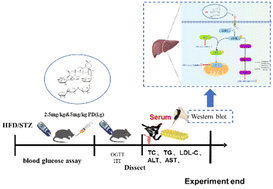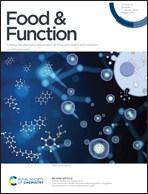Platycodin D ameliorates hyperglycaemia and liver metabolic disturbance in HFD/STZ-induced type 2 diabetic mice†
Abstract
In this work, we investigated the ameliorative effects of platycodin D (PD), a major active chemical ingredient isolated from the roots of Platycodon grandiflorum (PG), on high-fat diet (HFD)/streptozotocin (STZ)-induced type 2 diabetes (T2D) mice. PD treatment (2.5 and 5.0 mg kg−1) improved HFD-induced body weight gain. PD administration also decreased the fasting blood glucose (FBG) level and improved glucose and insulin tolerance levels. These data collectively showed that PD could maintain glucose homeostasis. In addition, the diabetic mice with PD treatment also showed fewer pathological changes in liver tissues and improved hepatic functional indexes with respect to the levels of aspartate aminotransferase (AST), alanine aminotransferase (ALT), and recovery of abnormal liver function caused by T2D. Except for these, PD decreased the decomposition of hepatic glycogen. The results from western blot analysis showed that PD treatment might regulate the hepatic gluconeogenesis pathway with the increased phosphorylation/expression of AMPK and decreased expressions of PCK1 and G6Pase. In the aspect of lipid metabolism, PD decreased the whole-body lipid levels, including total cholesterol (TC), triglycerides (TG), and high-density lipoprotein (HDL), and reduced the hepatic fat accumulation induced by T2D through the AMPK/ACC/CPT-1 fatty acid anabolism pathway. In addition, the results of molecular docking showed that PD may have a potential direct effect on AMPK and other key glycolipid metabolism proteins. To summarize, PD modulation of hepatic glycolipid metabolism abnormalities is promising for T2D therapy in the future.



 Please wait while we load your content...
Please wait while we load your content...